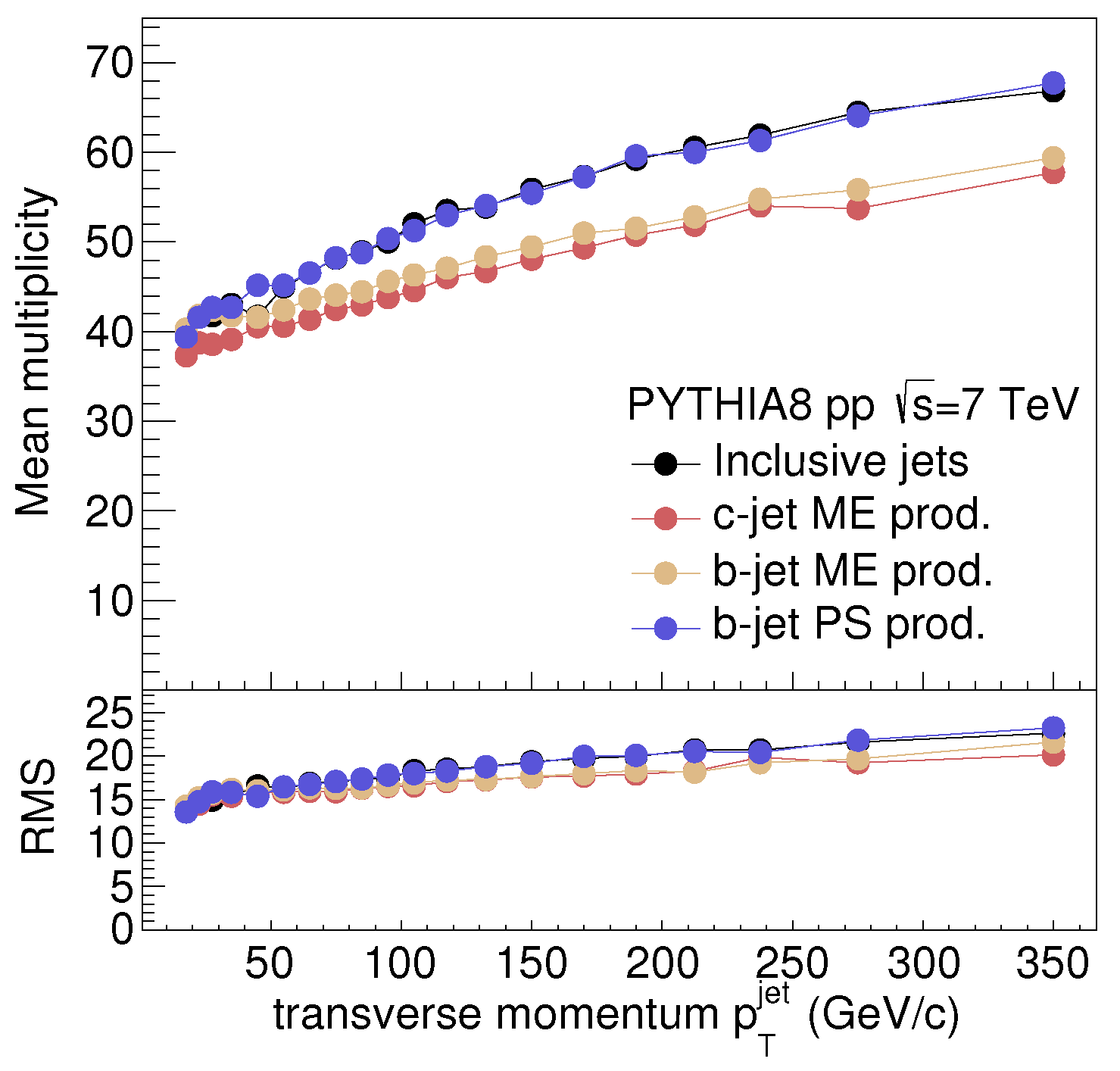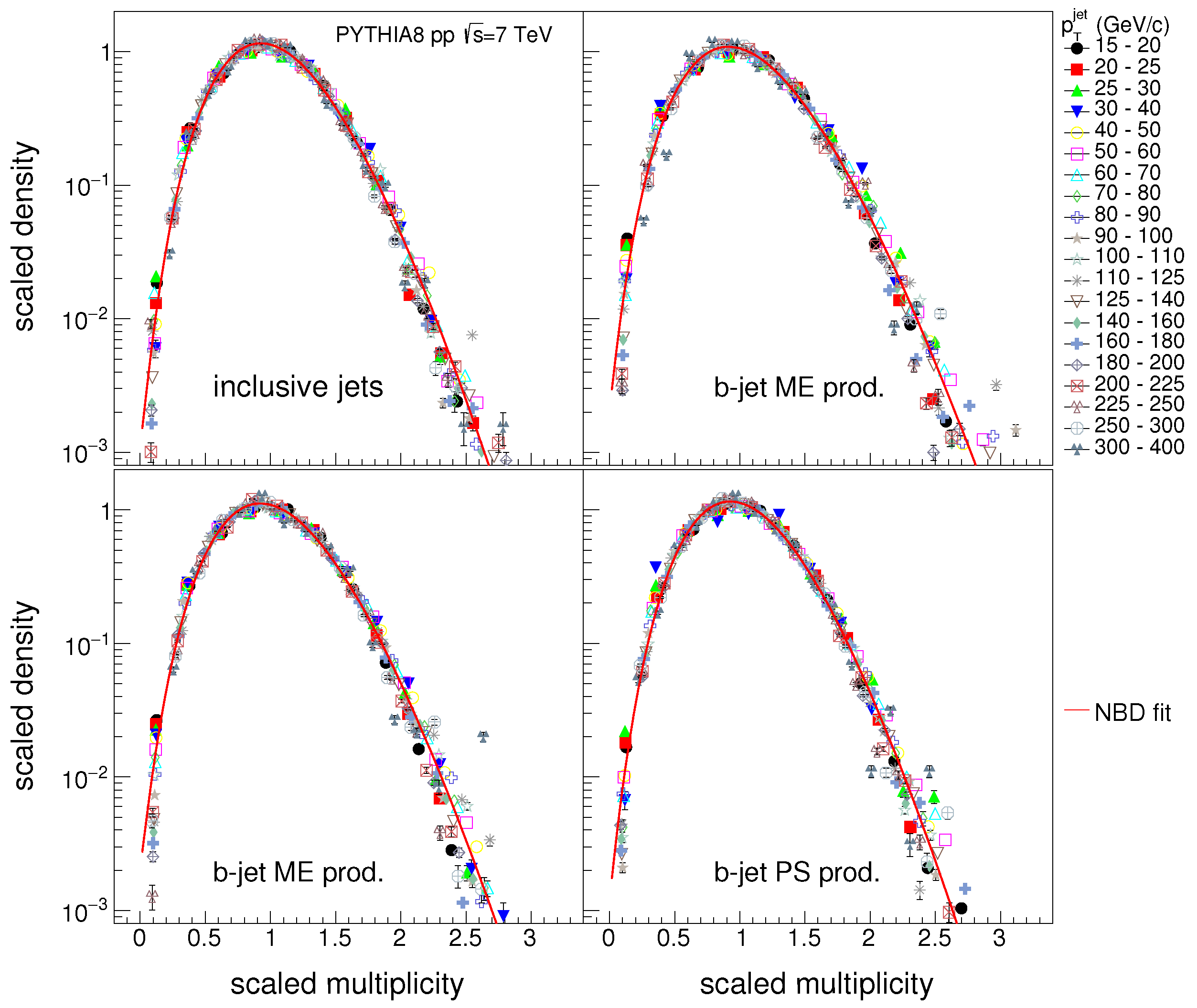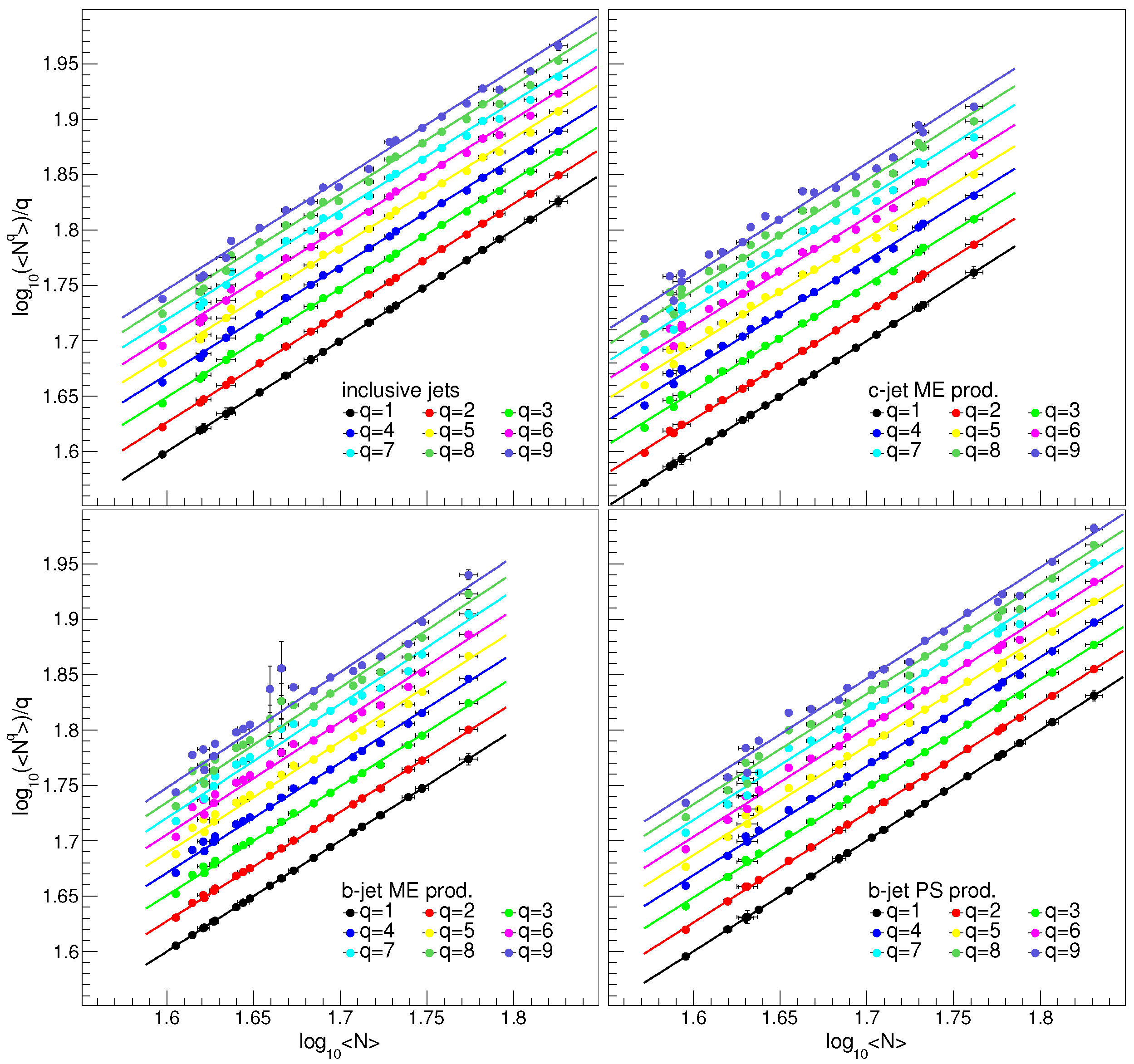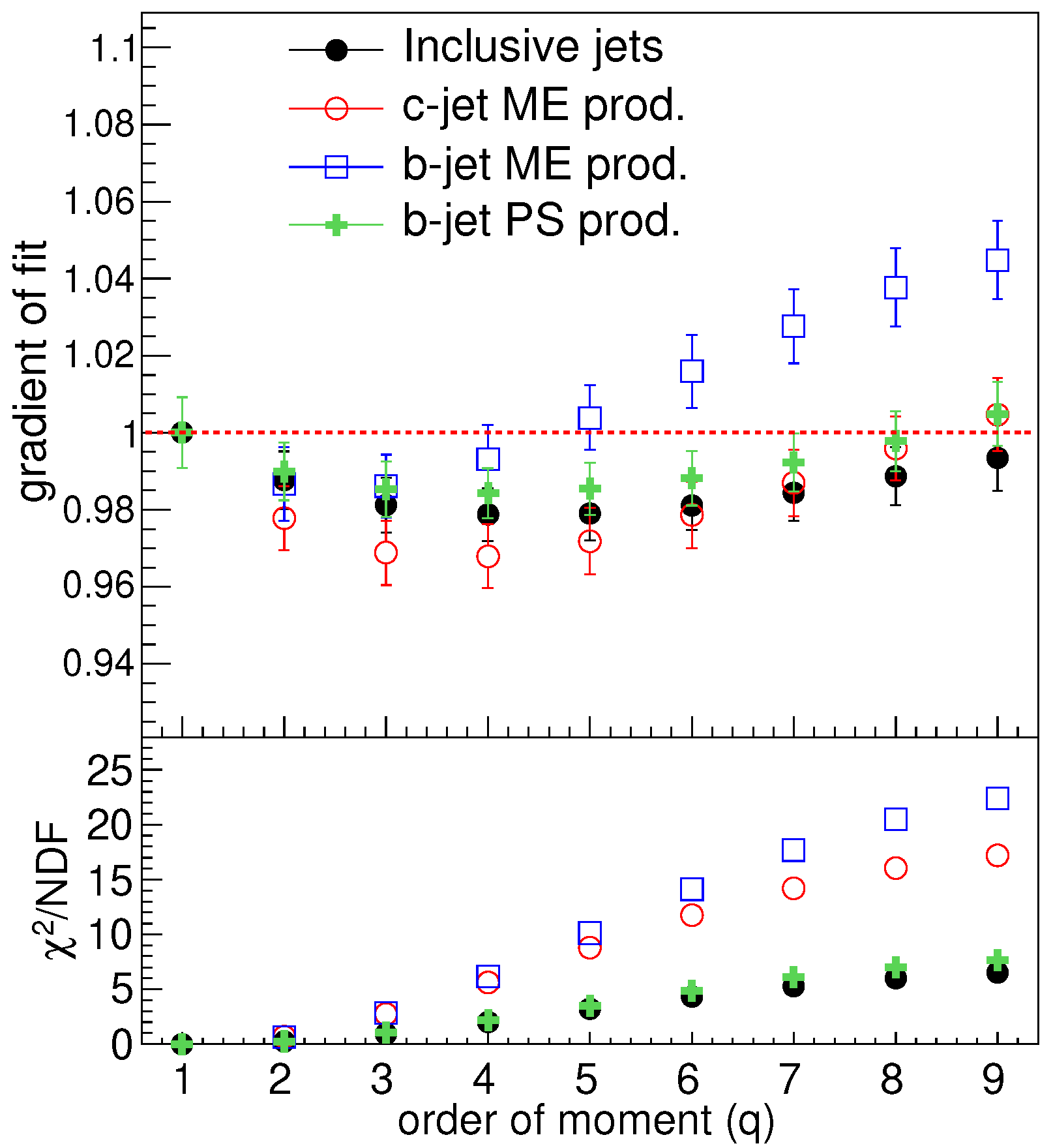The Partonic Origin of Multiplicity Scaling in Heavy and Light Flavor Jets
Abstract
1. Introduction
2. Analysis Method
3. Results and Discussion
4. Conclusions
Author Contributions
Funding
Institutional Review Board Statement
Informed Consent Statement
Data Availability Statement
Acknowledgments
Conflicts of Interest
References
- Chew, C.K.; Lim, Y.K. Charged Particle Multiplicity Distributions in e+e− Annihilation and Negative Binomial Distributions. Phys. Lett. B 1985, 163, 257–260. [Google Scholar] [CrossRef]
- Giovannini, A.; Van Hove, L. Negative Binomial Multiplicity Distributions in High-Energy Hadron Collisions. Z. Phys. C 1986, 30, 391. [Google Scholar] [CrossRef]
- Acharya, S.; Adamová, D.; Adolfsson, J.; Aggarwal, M.M.; AglieriRinella, G.; Agnello, M.; Agrawal, N.; Ahammed, Z.; Ahmad, N.; Ahn, S.U.; et al. Charged-particle multiplicity distributions over a wide pseudorapidity range in proton-proton collisions at = 0.9, 7, and 8 TeV. Eur. Phys. J. C 2017, 77, 852. [Google Scholar] [CrossRef]
- Koba, Z.; Nielsen, H.B.; Olesen, P. Scaling of multiplicity distributions in high-energy hadron collisions. Nucl. Phys. B 1972, 40, 317–334. [Google Scholar] [CrossRef]
- Polyakov, A.M. A Similarity hypothesis in the strong interactions. 1. Multiple hadron production in e+ e- annihilation. Zh. Eksp. Teor. Fiz. 1970, 59, 542–552. [Google Scholar]
- Alner, G.J.; Ansorge, R.E.; Åsman, B.; Böckmann, K.; Booth, C.N.; Burow, L.; Carlson, P.; Declercq, C.; DeWolf, R.S.; Eckart, B.; et al. Scaling Violations in Multiplicity Distributions at 200-GeV and 900-GeV. Phys. Lett. B 1986, 167, 476–480. [Google Scholar] [CrossRef]
- Arneodo, M.; Arvidson, A.; Aubert, J.J.; Badełek, B.; Beaufays, J.; Bee, C.P.; Benchouk, C.; Berghoff, G.; Bird, I.; Blum, D.; et al. Comparison of Multiplicity Distributions to the Negative Binomial Distribution in Muon—Proton Scattering. Z. Phys. C 1987, 35, 335, Erratum in Z. Phys. C 1987, 36, 512. [Google Scholar] [CrossRef]
- Lam, C.S.; Walton, M.A. A Proposal for the Origin of KNO Scaling. Phys. Lett. B 1984, 140, 246–248. [Google Scholar] [CrossRef]
- Kudo, K. Study of the Violation of KNO Scaling and the Validity of Modified KNO Scaling Based on the Cluster Model. Prog. Theor. Phys. 1985, 74, 1281–1289. [Google Scholar] [CrossRef]
- Burgers, G.J.H.; Hagedorn, R.; Kuvshinov, V. Multiplicity distributions in high-energy collisions derived from the statistical bootstrap model. Phys. Lett. B 1987, 195, 507. [Google Scholar] [CrossRef][Green Version]
- Hegyi, S. Renormalization group approach to multiparticle density fluctuations. Phys. Lett. B 1997, 411, 321–325. [Google Scholar] [CrossRef][Green Version]
- Matinyan, S.G.; Walker, W.D. Multiplicity distribution and mechanisms of the high-energy hadron collisions. Phys. Rev. D 1999, 59, 034022. [Google Scholar] [CrossRef]
- Vértesi, R.; Gémes, A.; Barnaföldi, G.G. Koba-Nielsen-Olesen-like scaling within a jet in proton-proton collisions at LHC energies. Phys. Rev. D 2021, 103, L051503. [Google Scholar] [CrossRef]
- Ilten, P.; Rodd, N.L.; Thaler, J.; Williams, M. Disentangling Heavy Flavor at Colliders. Phys. Rev. D 2017, 96, 054019. [Google Scholar] [CrossRef]
- Apolinário, L.; Lee, Y.J.; Winn, M. Heavy quarks and jets as probes of the QGP. arXiv 2022. [Google Scholar] [CrossRef]
- Dokshitzer, Y.L.; Khoze, V.A.; Troian, S.I. On specific QCD properties of heavy quark fragmentation (‘dead cone’). J. Phys. G 1991, 17, 1602–1604. [Google Scholar] [CrossRef]
- Acharya, S.; Adamova, D.; Adler, A.; Adolfsson, J.; Rinella, G.A.; Agnello, M.; Agrawal, N.; Ahammed, Z.; Ahmad, S.; Ahn, S.U.; et al. Direct observation of the dead-cone effect in quantum chromodynamics. Nature 2022, 605, 440–446. [Google Scholar] [CrossRef]
- Kučera, V. Measurements of groomed heavy-flavour jet substructure with ALICE. PoS 2021, 387, 149. [Google Scholar] [CrossRef]
- Varga, Z.; Vértesi, R.; Barnaföldi, G.G. Jet Structure Studies in Small Systems. Universe 2019, 5, 132. [Google Scholar] [CrossRef]
- Sjöstrand, T.; Ask, S.; Christiansen, J.R.; Corke, R.; Desai, N.; Ilten, P.; Mrenna, S.; Prestel, S.; Rasmussen, C.O.; Skands, P.Z. An introduction to PYTHIA 8.2. Comput. Phys. Commun. 2015, 191, 159–177. [Google Scholar] [CrossRef]
- Corke, R.; Sjöstrand, T. Interleaved parton showers and tuning prospects. J. High Energy Phys. 2011, 2011. [Google Scholar] [CrossRef]
- Chatrchyan, S.; Khachatryan, V.; Sirunyan, A.M.; Tumasyan, A.; Adam, W.; Bergauer, T.; Dragicevic, M.; Erö, J.; Fabjan, C.; Friedl, M.; et al. Jet and Underlying Event Properties as a Function of Charged-Particle Multiplicity in Proton–Proton Collisions at = 7 TeV. Eur. Phys. J. C 2013, 73, 2674. [Google Scholar] [CrossRef]
- Sirunyan, A.M.; Tumasyan, A.; Adam, W.; Asilar, E.; Bergauer, T.; Brandstetter, J.; Brondolin, E.; Dragicevic, M.; Erö, J.; Flechl, M.; et al. Measurement of charged pion, kaon, and proton production in proton-proton collisions at = 13 TeV. Phys. Rev. D 2017, 96, 112003. [Google Scholar] [CrossRef]
- Sjostrand, T.; van Zijl, M. A Multiple Interaction Model for the Event Structure in Hadron Collisions. Phys. Rev. D 1987, 36, 2019. [Google Scholar] [CrossRef]
- Sjostrand, T. The Lund Monte Carlo for Jet Fragmentation. Comput. Phys. Commun. 1982, 27, 243. [Google Scholar] [CrossRef]
- Varga, Z.; Vértesi, R.; Gábor Barnaföldi, G. Modification of jet structure in high-multiplicity pp collisions due to multiple-parton interactions and observing a multiplicity-independent characteristic jet size. Adv. High Energy Phys. 2019, 2019, 6731362. [Google Scholar] [CrossRef]
- Strong, G.C. Gluon Splitting to B-Quark Pairs in Proton-Proton Collisions at = 8 TeV with ATLAS. Master’s Thesis, University of Glasgow, Glasgow, UK, 2015. [Google Scholar]
- Cacciari, M.; Salam, G.P.; Soyez, G. The anti-kt jet clustering algorithm. J. High Energy Phys. 2008, 2008, 63. [Google Scholar] [CrossRef]
- Chatrchyan, S.; Khachatryan, V.; Sirunyan, A.M.; Tumasyan, A.; Adam, W.; Aguilo, E.; Bergauer, T.; Dragicevic, M.; Ero, J.; Fabjan, C.; et al. Identification of b-Quark Jets with the CMS Experiment. JINST 2013, 8, P04013. [Google Scholar] [CrossRef]
- Acharya, S.; Adamova, D.; Adler, A.; Adolfsson, J.; Aglieri Rinella, G.; Agnello, M.; Agrawal, N.; Ahammed, Z.; Ahmad, S.; Ahn, S.U.; et al. Measurement of inclusive charged-particle b-jet production in pp and p-Pb collisions at = 5.02 TeV. JHEP 2022, 1, 178. [Google Scholar] [CrossRef]




Publisher’s Note: MDPI stays neutral with regard to jurisdictional claims in published maps and institutional affiliations. |
© 2022 by the authors. Licensee MDPI, Basel, Switzerland. This article is an open access article distributed under the terms and conditions of the Creative Commons Attribution (CC BY) license (https://creativecommons.org/licenses/by/4.0/).
Share and Cite
Varga, Z.; Vértesi, R. The Partonic Origin of Multiplicity Scaling in Heavy and Light Flavor Jets. Symmetry 2022, 14, 1379. https://doi.org/10.3390/sym14071379
Varga Z, Vértesi R. The Partonic Origin of Multiplicity Scaling in Heavy and Light Flavor Jets. Symmetry. 2022; 14(7):1379. https://doi.org/10.3390/sym14071379
Chicago/Turabian StyleVarga, Zoltán, and Róbert Vértesi. 2022. "The Partonic Origin of Multiplicity Scaling in Heavy and Light Flavor Jets" Symmetry 14, no. 7: 1379. https://doi.org/10.3390/sym14071379
APA StyleVarga, Z., & Vértesi, R. (2022). The Partonic Origin of Multiplicity Scaling in Heavy and Light Flavor Jets. Symmetry, 14(7), 1379. https://doi.org/10.3390/sym14071379





